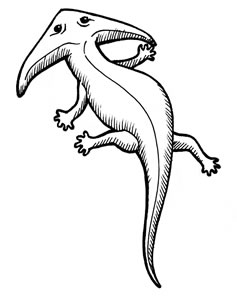315 Million Years Ago
 THIS LITTLE SCULPTURE is a reconstruction of a rare fossil called Keraterpeton, found in the coal mines of Kilkenny. Keraterpeton was one of an amazing variety of amphibians that evolved rapidly in the coal swamps of the late carboniferous, about 315 million years ago. The boulder is of local limestone laid down in the early Carboniferous, about 359 million years ago, when the polar ice caps melted and the sea level rose, flooding much of the old Devonian continent under a warm shallow sea.
THIS LITTLE SCULPTURE is a reconstruction of a rare fossil called Keraterpeton, found in the coal mines of Kilkenny. Keraterpeton was one of an amazing variety of amphibians that evolved rapidly in the coal swamps of the late carboniferous, about 315 million years ago. The boulder is of local limestone laid down in the early Carboniferous, about 359 million years ago, when the polar ice caps melted and the sea level rose, flooding much of the old Devonian continent under a warm shallow sea.
The amphibians were the first major group of land vertebrates, related to modern frogs, newts and salamanders. They were limited to wet places by their porous skins and their need to lay eggs in water. The reptiles would soon evolve to solve both these problems, becoming the dominant land vertebrates about 270 million years ago. That will be the subject of the next station, marked by a bronze sculpture of a small lizard on a boulder of chalk.
DURING THE EARLY Carboniferous, two continental plates the earth’s crust were moving towards each other, north and south of the equator. As they approached, the sea between them became shallow and muddy, eventually developing into an enormous tropical swamp-forest.
The Carboniferous forest consisted of completely new species of trees, unrelated to the Archaeopteris species of the Devonian, which were already extinct. On the forest floor, a peat layer developed, up to 30 metres thick. This is preserved in many places in the world as a band of coal.
When the amphibians appeared, there was already plenty to feed upon. The swamp forest was populated by a huge variety of creatures, especially arthropods. These included flying insects and huge millipedes, which fed on plants and rotting vegetation. Within a comparatively short time, the amphibians developed a huge range of characters and lifestyles. Some lost their legs to become snakelike, while others returned to an aquatic way of life. Among them were a group that broke away from dependence on water, evolving into the reptiles, as we shall see at the next station.